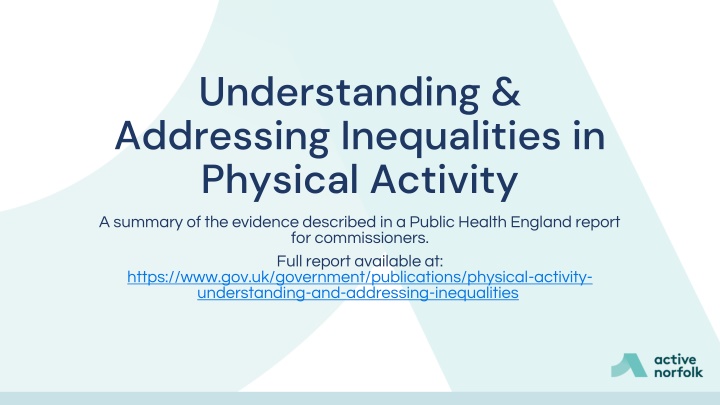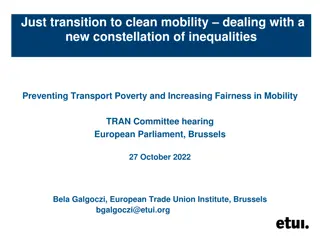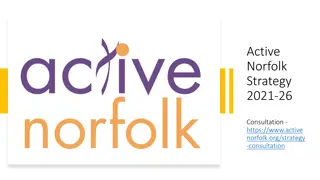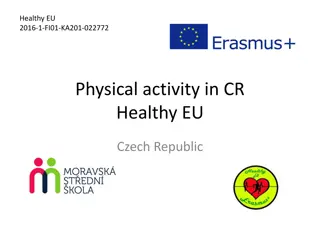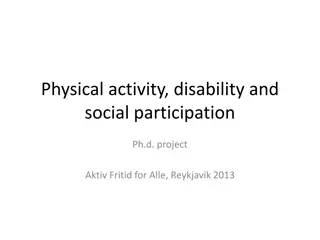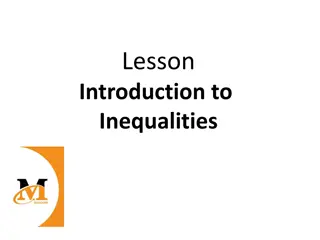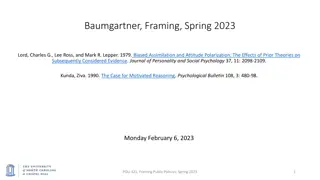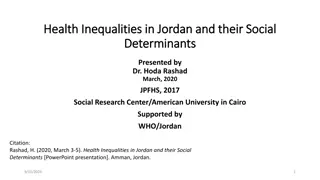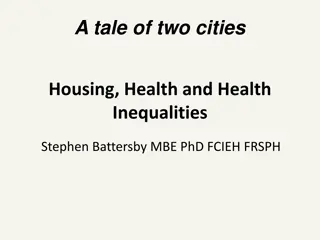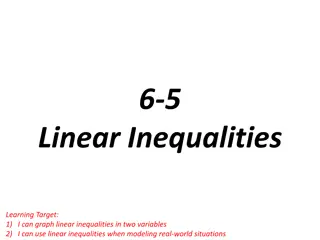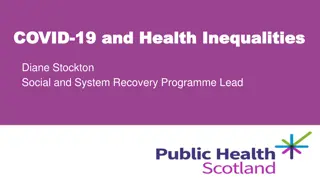Addressing Inequalities in Physical Activity: Summary of Evidence
This report highlights research by the University of Derby on inequalities in physical activity among different demographic groups. Findings show disparities in PA levels that require immediate action to address. Health is influenced by various factors, including genetics, lifestyle, environment, access to healthcare, social support, and socioeconomic status. Inequalities exist due to these determinants, affecting individuals' health outcomes. Increasing physical activity has positive impacts on both physical and mental health, emphasizing the need to address inequalities in PA interventions.
Download Presentation

Please find below an Image/Link to download the presentation.
The content on the website is provided AS IS for your information and personal use only. It may not be sold, licensed, or shared on other websites without obtaining consent from the author.If you encounter any issues during the download, it is possible that the publisher has removed the file from their server.
You are allowed to download the files provided on this website for personal or commercial use, subject to the condition that they are used lawfully. All files are the property of their respective owners.
The content on the website is provided AS IS for your information and personal use only. It may not be sold, licensed, or shared on other websites without obtaining consent from the author.
E N D
Presentation Transcript
Understanding & Addressing Inequalities in Physical Activity A summary of the evidence described in a Public Health England report for commissioners. Full report available at: https://www.gov.uk/government/publications/physical-activity- understanding-and-addressing-inequalities
Terminology Protected characteristics Protected characteristics are characteristics that it is against the law to discriminate against. These include age, disability, gender reassignment, race, religion or belief, sex, sexual orientation, marriage and civil partnership and pregnancy and maternity. Determinants of health. Determinants of health. Health is influenced by many factors including: - Genetics Genetics - Lifestyle/behaviour Lifestyle/behaviour - E Environmental and physical influences nvironmental and physical influences - A Access and use of health services ccess and use of health services - S Social support networks ocial support networks - Education, income and social status Education, income and social status
Introduction This report presents the findings of research carried out by the University of Derby, which aimed to further understand levels of inequalities in PA across and within protected characteristic groups. They reviewed the literature, analysed Active Lives Survey data (2015-20), and undertook qualitative research with PA providers. The results identified a range of inequalities in individual s PA levels from different protected characteristic groups and therefore changes are needed immediately to reverse these.
Introduction to PA inequalities Health is influenced by more than just individual lifestyle, biology or genetics. Wider determinants such as socio-economic, cultural and environmental conditions also play a major role. The context of people s lives determine their health, and so blaming individuals for having poor health or crediting them for good health is inappropriate. Individuals are unlikely to be able to directly control many of the determinants of health. Inequalities in health exist because these wider determinants vary significantly across population groups. These determinants can influence adverse health behaviours in socially specific groups which can then lead to adverse marked differences in life expectancy. Physical inactivity negatively impacts both physical and mental health and it is in the top 10 greatest causes of ill health nationally. An increase in PA can positively impact health, social and economic status, An increase in PA can positively impact health, social and economic status, meaning it can have a positive correlation between outcomes and structural meaning it can have a positive correlation between outcomes and structural inequalities. inequalities.
Introduction to PA inequalities There is a wide range of evidence-based interventions which aim to increase population based PA. However, evidence suggests that many interventions exacerbate inequalities for communities with protected characteristics. Understanding and acting on inequalities in PA is a crucial part of a systemic approach to delivering effective interventions which will have multiple benefits to those with the greatest need.
Considerations for tackling inequalities in children and young people Focus on enjoyment, socialising and using unstructured, informal activities. Involving the target audience, e.g. families or adolescents, in designing interventions improves engagement and makes them more likely to succeed. Provide a positive social environment for PA, including parents. Families should be shown how to change behaviours and not just told. Providing a taster session could help to engage families to participate in new activities and could also stimulate the change to be active. Offer a diverse range of activities suitable for all children regardless of ethnicity and long-term conditions. Competition appeals to some more than others. Activities need to be as low cost as possible whilst maintaining quality. Vouchers may enable children of low socio-economic status to access more PA opportunities. Consider use of positive role models or peer to peer support Convenient time and location important for families
Considerations for tackling inequalities for those with a physical disability Offer a diverse range of leisure activities as an accessible route to wellbeing for adults and children living with a physical disability. Develop an understanding of the individuals to tailor interventions to their need. Involve them in the design. Provide psychological support and focus on abilities, including opportunities to develop skills and overall function ability, as well as 1-1 tailored support. Encourage socialising and peer support. Interventions need to be welcoming, first impressions are very important. Disabled individuals choose websites regardless of their age to access key information, therefore, accessible online information is key. Health and sports practitioners are also a good way of providing information. Children living with a disability want more understanding and acceptance, more choice of activities, more motivation and encouragement
Considerations for tackling inequalities for those with a learning disability Avoid repetitive tasks and adapt interventions to fit the individual's unique cognitive challenges. Involve carers in facilitating and enabling behaviour change Ensure residents care providers are educated on the importance of PA Interventions delivered in mainstream services where possible Activities should be positive, value health, mental strength, wellbeing and be fun Possible use of intergenerational, buddy or advocate approaches Interventions must proactively consider ability, age, lack of opportunities, awareness/visibility of sessions, accessibility of venue/location and transport as none of these should be a barrier to people with a learning disability attending Consider using a peer-guided model to integrate social and instructional support within the community for children with a learning disability
Considerations for tackling inequalities for LGBTQ+ LGBTQ+ devoted activities important to provide safe spaces, overcome fear of acceptance, and provide social support. Work in partnership with local LGBTQ+ communities to help design interventions and foster a safe environment. Diversity training is crucial to understand different communities. The collective workforce must challenge their own bias. Consider the different needs of groups within LGBTQ+ banner Social attitudes have meant that there has been a reluctance to recognise that PA participation by LGBTQ+ can be problematic. This is an area for change to progress PA for LGBTQ+ individuals for the future. More needs to be done to integrate LGBTQ+ needs in policy or thinking in the context of PA, health, education, and social inclusion.
Considerations for tackling inequalities for long-term conditions Improve individuals living with a LTC s understanding of the benefits of PA along with resources to help improve knowledge of PA for health care professionals. Interventions should offer standardised advice relating to optimal intensities, durations, and types of PA. which provide a baseline from which to tailor advice Post-intervention maintenance classes could also help to foster long-term supportive social networks for PA. Offer a choice of various activities, supervised gym sessions, seated aerobics, step classes, circuit training, swimming, etc. Use phrases like every moment matters , it is never too late , every step counts and it s good to be active , not homing in on PA , exercise . The benefits of PA do not address the barriers. Messages that claim to improve symptoms do not encourage changes in behaviour and commissioners must consider these in delivery of interventions. Valued benefits include improved self- esteem, mood, confidence and motivation.
Considerations for tackling inequalities for mental health The delivery venue/environment needs careful consideration. It needs to be easy and friendly to navigate. Information is accessible and well communicated. Background noise, distractions, visibility (is the activity on display) etc considered. A clear demonstration of the exercise should be provided because copying a movement may be easier than following verbal instructions. Offer individual support not just groups. This could be through web-based support. Important to understand the individual s social environment and motivation as this will provide important information on how to support them. Social and peer support are key enablers. Should be enjoyable to increase intrinsic motivation. Individuals want to feel autonomy, competence, and connectedness, by focusing on fun, learning new skills, improvements in self-esteem and confidence Share good practice to support coach or leader recruitment and development
Considerations for tackling inequalities for ethnic minorities Include community approaches not just targeting individuals. Need to gain experience and knowledge of the ethnic minority populations within the community in order to gain a contextual approach. Individuals need to be actively involved in the design of interventions within their community. Consideration for culturally appropriate facilities and use of peer mentors Provide advice on integrating PA in everyday life Group based PA is important and can be facilitated through religious, community, friendship or family networks. Engage with existing role models where possible. Enablers for CYP of an ethnic minority group include play, schooltime and an increase of extra- curricular clubs A social approach, encouraging the groups to undertake activities with family or friends and with bilingual peers can facilitate engagement, motivation and support Consider women only interventions and look at offering financial assistance
Considerations for tackling inequalities for religious groups making links with religious leaders and training them to be involved in delivery of the interventions or advocate PA Using places of worship to deliver the interventions can help engage the population and save on costs needs be delivered in a setting that is culturally appropriate and considers both male and females and family needs Engaging in consultation with the target group is crucial to understand enablers and barriers Religious obligations may be a priority; therefore, any intervention design needs to closely consider this.
Considerations for tackling inequalities for older adults Lifestyle counselling for adapting and creating community-based health interventions around retirement years Promote behaviours and outcomes that have recreational value and should only target acceptable levels of PA to the individual Health status and enjoyment (or not) of PA were deemed crucial; experiencing poor health was more of a motivator to getting physically active Links with PA to mobility and independence was more credible than linking to disease prevention or symptom management Some older adults felt that PA classes should be pitched at ability level, not age, with the ability to socialise and trusted support seen as key Petting the messaging right (positive messages which are visual, fun and can be part of everyday life, not messages of overcoming loneliness and relating to illnesses) and not one-size-fits-all
Considerations for tackling inequalities for older adults Positive instructors who do not doubt their physical capability and role models The may not feel comfortable in gyms and therefore different and exciting activities should be offered
Considerations for tackling inequalities for socioeconomic Improving accessibility to greenspaces and facilities Once people are active, high levels of social interaction, interest and enjoyment are associated with improved levels of retention Individuals from a lower socioeconomic background were more inactive compared to a higher socioeconomic status. However, active travel (walking and cycling) for lower socioeconomic status individuals was greater than those from a higher socioeconomic status and possibly something to be investigated and promoted more.
Considerations for tackling inequalities for women A social marketing model may be a useful framework to designing a community- based intervention to engage pregnant women Making physical activity or movement the norm for women relies on local women of all ages, sizes and faiths not only becoming active, but celebrating it and encouraging others to join in Requires positivity, support, and encouragement to drive action. Interventions need to be easy for women access, the physical activity must be at the right time, right place, involve the right welcome, have the right company and them to be aware of the right equipment or clothing. For younger girls, seek role models and develop young female leaders to have a significant impact on community group involvement. Community champion volunteers have been cited as influential in engaging woman and girls. Their involvement with recruitment to sessions and support in sessions is crucial and importantly allows the women to feel empowered.
Recommendations Workforce Workforce The study has highlighted urgent action which is needed to ensure the PA workforce is diversely represented. Solutions should be sought in partnership with communities so that individuals can take ownership of what is being delivered. Diversity training which challenges own bias should be mandatory for all workforces. Opportunities for role models and peer-to-peer influencing, is important to foster autonomy and empowerment for all communities.
Recommendations Interventions Interventions Interventions should meet practical, environmental, social, and psychological individual needs. Use demographic data to ensure intervention design is targeted and in direct consultation with the community to ensure interventions are needs driven. A range of accessible communication tools are needed across languages and literacy in forms such as braille and sign language to enable engagement. Different sectors should work together to enable mutual understandings of opportunities. Best practice and learning should be shared widely and across sectors. All sectors have a responsibility to promote and encourage PA.
